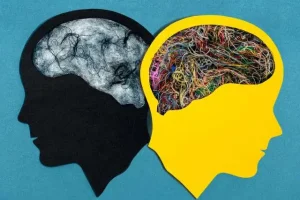Bipolar disorder, also known as manic depression, is a mental health condition characterised by extreme shifts in mood. Key symptoms include episodes of mania – extreme elevated mood, with episodes of depression – extreme low mood. In 2020, it has been estimated around 2.8% of world population has bipolar disorder, which equate to approximately 220 million people around the world living with this condition. Before we dive into the Asian context, let’s first have a look at what bipolar disorder is about.

Figure 1 Two extreme sides of bipolar disorder
What are the symptoms?
As mentioned, patients with bipolar disorder have extreme episodes of elevated and depressed mood. However, based on the main presentation, we can classify them into three different types.
- Type 1: Type 1 bipolar is defined by the appearance of at least one manic episode. People can have either manic or hypomanic episodes, which are less extreme than manic episodes. Major depressive usually occurs but is not required for clinical diagnosis. It affects male and female equally.
- Type 2: Type 2 bipolar is characterised by at least one episode of hypomania and one major depressive episode, without any previous episode of mania. This type of bipolar may be more common in female.
- Cyclothymia: The most complicated type among the three types of bipolar disorders. It comes with three defining features:
- Patients experience persistent instability of mood involving numerous periods of depressive symptoms and periods of hypomanic symptoms.
- Symptoms are not sufficiently severe or persistent enough to be classified into Type 1 or Type 2.
- Symptoms last at least 2 years and are present at least half of the time, and are never absent for more than 2 months at a time.
However, what is mania exactly? We all experience periods of elevated mood, but to what extend should it be recognised as extreme? In short, mania is the type of behaviour that stands out. For example, you may strongly disagree with a journalist, and not only do you spend a night writing a 500-word post, you also attempt to find out all the websites connected to the journalist so that you can post your opinions on every one of them. To some extent, manic episodes are compulsive and patients usually do not realise it.
What are the causes?
Like most other mental conditions, there are no definitive answer to what actually causes them. Some factors might trigger bipolar disorder include:
- Family history
- Increased paternal age: sperm generation tends to be faultier in older males. A faulty gene could cause bipolar disorder in the children.
- Medication: some anti-inflammatory steroids may have the potential to cause bipolar disorders.
- Childhood trauma
- Psychosocial stress
- Sleep disorders
- Other non-specific illness
What are the treatment options for bipolar disorder?
Sadly, most mental conditions are not as clear cut as other physical illness. Treatment options do not cure the disorder but only alleviate the symptoms. Usually, patients would be referred to psychiatrist for professional assessment.
For patients in manic or depressive episodes, medication should be taken to calm down the patients and prevent harm to themselves and others. Mood stabilisers like lithium, antipsychotics, antidepressant, and benzodiazepines are commonly prescribed medications.
Cognitive behavioural therapy, psychoeducation, interpersonal and social rhythm therapy could prevent the onset of symptoms in the long term.
Situation in Asia
Very limited data is available on the prevalence of bipolar disorder in Asia. From currently available research and data, the prevalence is lower than western countries, particularly the USA, where the prevalence is around 3 times as compared to Japan. A more recent 2020 study on the prevalence of mental conditions in South Asia concluded that only 0.6% of the population has bipolar disorder, which is significantly lower than the world average of 2.8%. But whether it is a case of under-reporting as a result of poor awareness, we will never be certain.
Looking into the Asian situation, regional and cross-national studies reveal a mania-predominant course in bipolar disorder in Asia. Long-term depressive episodes and comorbid anxiety disorders worsen the course of Type 2 bipolar. Male patients commonly have substance use comorbidity and suicidal behaviours are more frequent in female patients. The lack of social awareness and health facilities in many regions are still major contributing factors to bipolar related death.
This article is written in conjunction with World Bipolar Day, held on the 30 March of every year.
